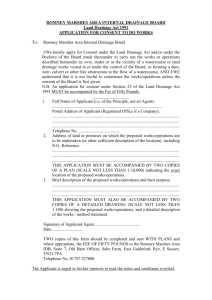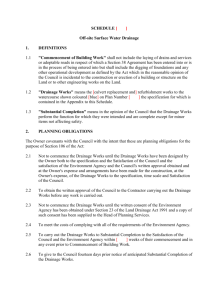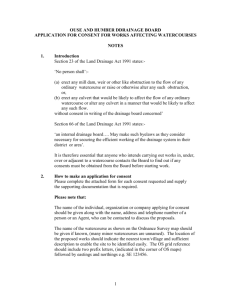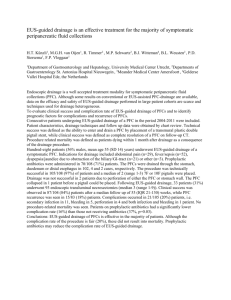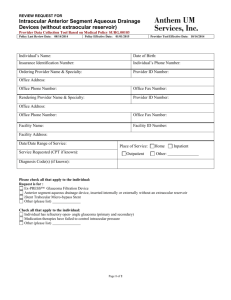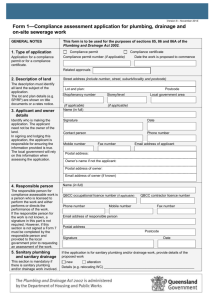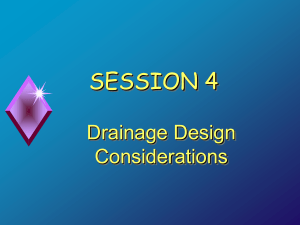Our Ref: - Somerset Drainage Boards Consortium
advertisement
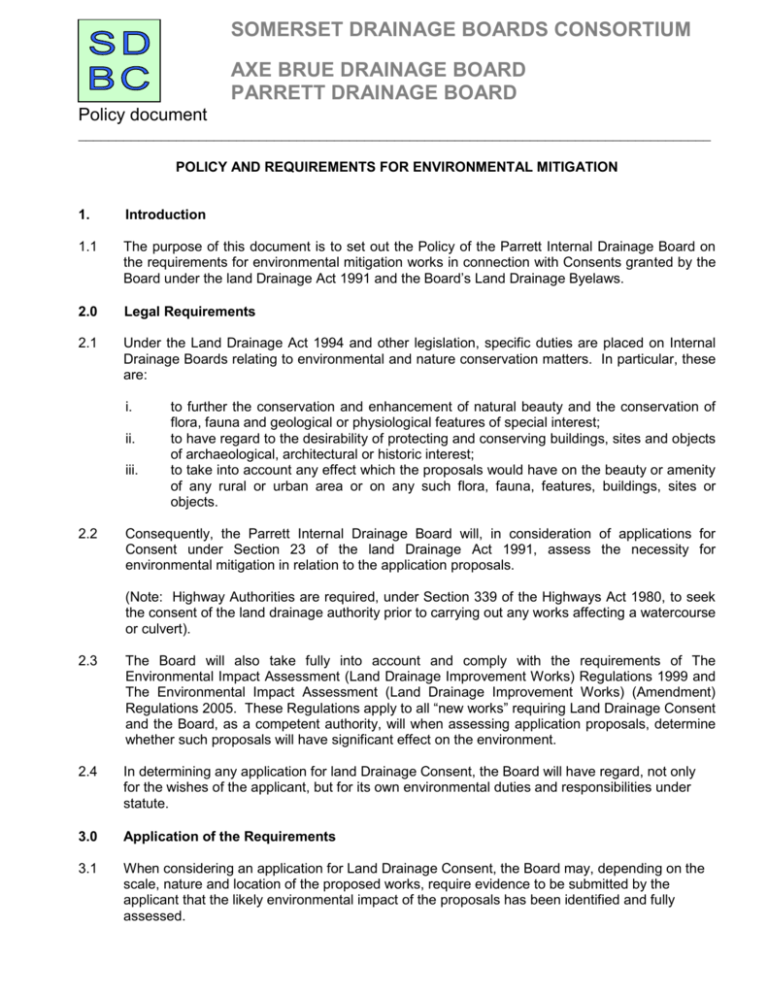
SOMERSET DRAINAGE BOARDS CONSORTIUM I AXE BRUE DRAINAGE BOARD PARRETT DRAINAGE BOARD Policy document ____________________________________________________________________________________ POLICY AND REQUIREMENTS FOR ENVIRONMENTAL MITIGATION 1. Introduction 1.1 The purpose of this document is to set out the Policy of the Parrett Internal Drainage Board on the requirements for environmental mitigation works in connection with Consents granted by the Board under the land Drainage Act 1991 and the Board’s Land Drainage Byelaws. 2.0 Legal Requirements 2.1 Under the Land Drainage Act 1994 and other legislation, specific duties are placed on Internal Drainage Boards relating to environmental and nature conservation matters. In particular, these are: i. ii. iii. 2.2 to further the conservation and enhancement of natural beauty and the conservation of flora, fauna and geological or physiological features of special interest; to have regard to the desirability of protecting and conserving buildings, sites and objects of archaeological, architectural or historic interest; to take into account any effect which the proposals would have on the beauty or amenity of any rural or urban area or on any such flora, fauna, features, buildings, sites or objects. Consequently, the Parrett Internal Drainage Board will, in consideration of applications for Consent under Section 23 of the land Drainage Act 1991, assess the necessity for environmental mitigation in relation to the application proposals. (Note: Highway Authorities are required, under Section 339 of the Highways Act 1980, to seek the consent of the land drainage authority prior to carrying out any works affecting a watercourse or culvert). 2.3 The Board will also take fully into account and comply with the requirements of The Environmental Impact Assessment (Land Drainage Improvement Works) Regulations 1999 and The Environmental Impact Assessment (Land Drainage Improvement Works) (Amendment) Regulations 2005. These Regulations apply to all “new works” requiring Land Drainage Consent and the Board, as a competent authority, will when assessing application proposals, determine whether such proposals will have significant effect on the environment. 2.4 In determining any application for land Drainage Consent, the Board will have regard, not only for the wishes of the applicant, but for its own environmental duties and responsibilities under statute. 3.0 Application of the Requirements 3.1 When considering an application for Land Drainage Consent, the Board may, depending on the scale, nature and location of the proposed works, require evidence to be submitted by the applicant that the likely environmental impact of the proposals has been identified and fully assessed. SOMERSET DRAINAGE BOARDS CONSORTIUM I AXE BRUE DRAINAGE BOARD PARRETT DRAINAGE BOARD Policy document ____________________________________________________________________________________ 3.2 The Board will then consider whether an opportunity exists to further the conservation and enhancement of the natural environment and, in situations where this is judged to be the case, will advise the applicant that for aConsent to be granted the proposals should include appropriate, environmentally beneficial works. These might include the re-profiling of a retained open watercourse to provide a “wet berm” for aquatic planting, the creation of an off-line pond or other water feature or the planting of appropriate native bankside trees and/or shrubs. 3.3 The Board will also consider whether the implementation of the proposals is likely to result in direct environmental impact e.g. the culverting or filling of a watercourse, or an indirect environmental impact e.g. from increased surface water run-off or a significant alteration of the natural water-table. 3.4 The Board considers it equally important, that where watercourses are to remain open, an adequate width of undeveloped land is retained adjacent to the channel for maintenance purposes and for the continuity of the natural environment and wildlife habitats. 3.5 Applicants must be able to demonstrate that they have considered alternatives, including costs, and show that appropriate facilities for future maintenance form a part of the proposals. 3.6 The Board recognises that there will be situations where it is necessary to infill ditches and minor watercourses to allow development, which has the benefit of planning approval, to proceed. In these cases, the Board will need to be satisfied that adequate arrangements are made for land drainage and sub-soil flows to prevent future water-logging of the site. The applicant must provide appropriate details with the application to demonstrate that these issues have been addressed. 3.7 Applicants should also be aware that Land Drainage Consents may be “Conditional” by the Board and that these conditions may include the requirement for mitigation works similar to those outlined above, to be undertaken. Consent does not override an adjacent landowners’ rights nor does it permit interference with legally protected wildlife habitats. 4.0 Protected Species 4.1 The attention of applicants is also drawn to the Wildlife and Countryside Act 1981 (as amended) and to the Countryside and Rights of Way Act 2000, which give legal protection to many species of flora and fauna. The Board’s duties, as outlined above, require that it must take account of the above Acts, when considering an application for Land Drainage Act Consent. 4.2 Among the species protected and potentially to be found in a watercourse or wetland situation are water vole, otters, great crested newts, breeding birds, bats and badgers. It is an offence to intentionally damage, destroy or obstruct a place where protected species shelter or to disturb the species whilst it is using such a place. Several rare aquatic plants are also protected under these Acts. 4.3 In any situation where evidence submitted by an applicant indicates that the likely environmental impact of the proposals will be to adversely affect any protected species, the Board will consult SOMERSET DRAINAGE BOARDS CONSORTIUM I AXE BRUE DRAINAGE BOARD PARRETT DRAINAGE BOARD Policy document ____________________________________________________________________________________ Natural England (and any other relevant conservation body) before determining the application. In all such situations, the advice received will be fundamental to the Board’s decision. 4.4 Where an application, that might otherwise have been approved, is refused on the advice of Natural England, or any other relevant conservation body, the Board will first advise the applicant of the grounds for refusal and invite an amended application, modified to overcome the conservation objection. 4.5 It should be noted that the legislation is not intended to prevent development or essential maintenance works, and it may be sufficient that the proposed timing of the works recognises the presence of protected species at particular times of the year and is undertaken at a time chosen to avoid damage or disturbance. 4.6 For specific advice on protected species legislation, applicants should consult Natural England at their Taunton Office. 5.0 Other Matters 5.1 The issue of a Land Drainage Consent by the Parrett or Axe Brue Internal Drainage Board does not absolve a person proposing to execute works from the need to obtain such other licences, consents or permissions which may be required by law. 5.2 If the consent or approval of a third party is required before the applicant is able to carry out any of the works proposed, documentary evidence of this consent or approval must be submitted with the application. 5.3 Reference should also be made to “Guidance Notes for Applicants”, “Policy Regarding Culverts and the Culverting of Watercourses” and “Summary of Requirements for Small Pipe Outfalls”. 1 April 2012
